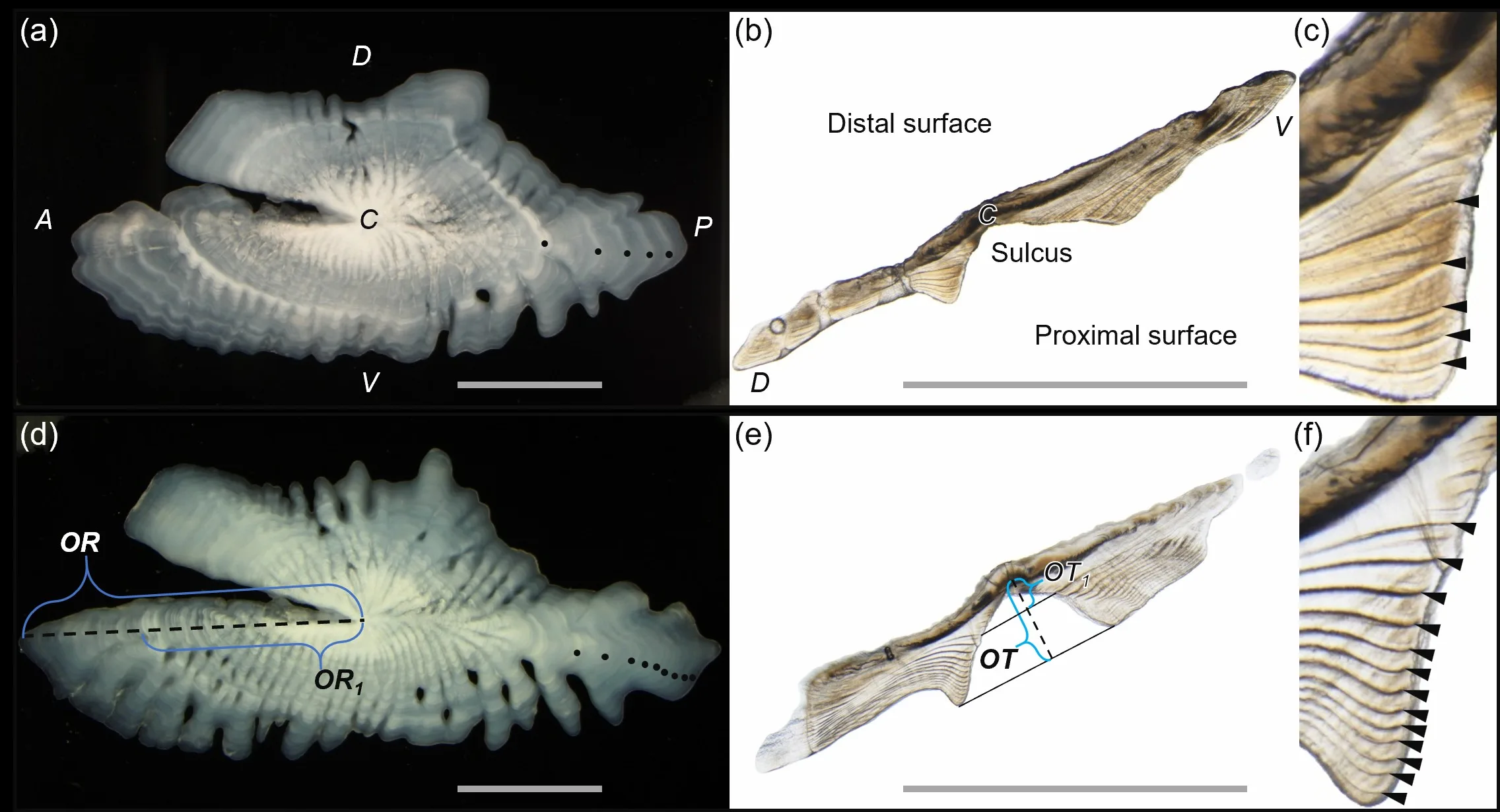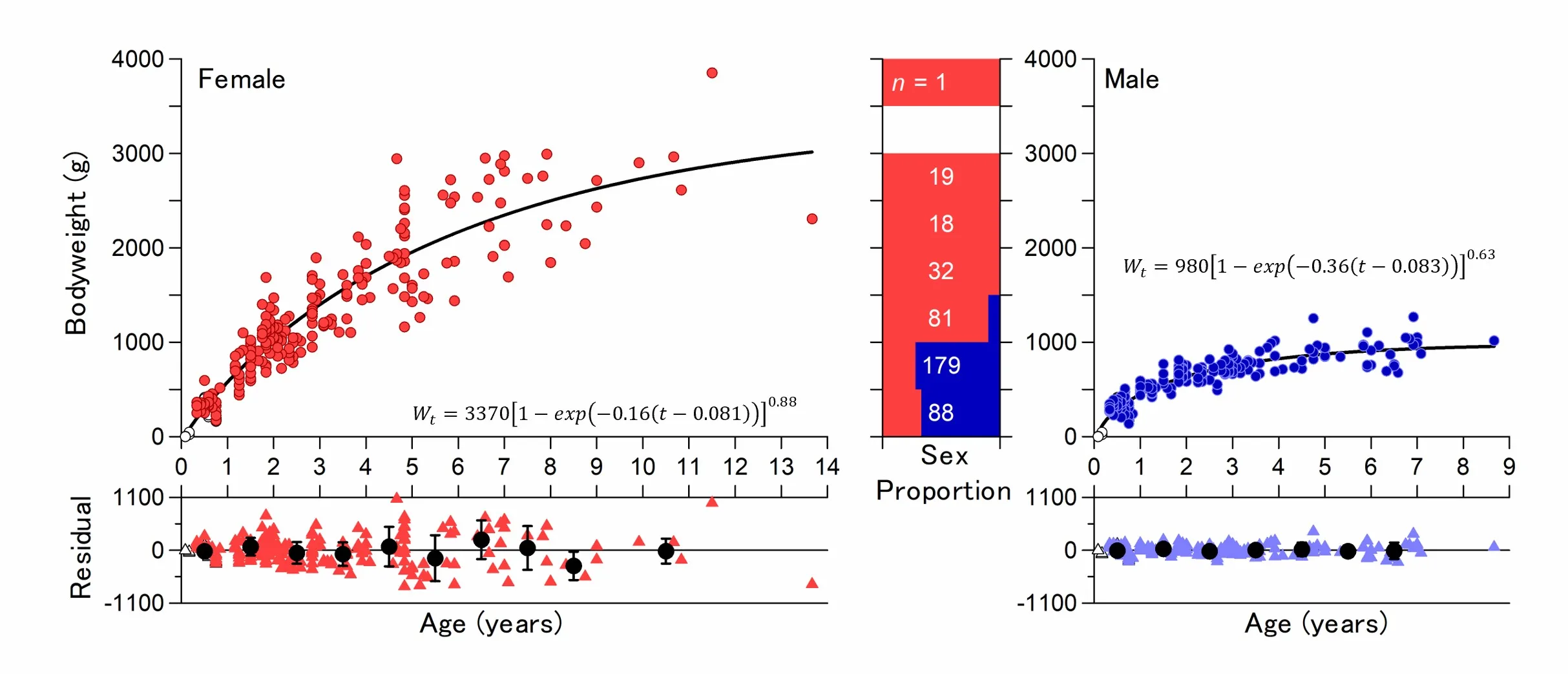

Higher Salinity in Inner Bays Causes a “Missing Generation” in Japanese Silver Pomfret― Salinity, Not Temperature, Is the Key Factor
Professor Atsuko Yamaguchi and Researcher Yoshimi Ogino of the Graduate School of Integrated Science and Technology, Nagasaki University, found that although the number of parent fish migrating to Ariake Bay stayed the same, no Japanese silver pomfret born in 2017 were observed. They identified this as a “missing generation” of the species. Their investigation revealed that even a slight increase in salinity in the inner bay during the breeding season can cause reproductive failure in that year. Rainfall patterns and freshwater inflow from rivers significantly influence salinity levels, which strongly affect the species’ reproductive success.
1.

The study revealed that even a slight increase in salinity in the innermost reproductive areas of Ariake Bay can cause reproductive failure in Japanese silver pomfret in that year.
2.

(a, d) Photographs of distal surface and (b, c, e, f) sections of the left sagittal otolith extracted from (a–c) a 5-year-old female and (d–f) a 13-year-old female of Pampus punctatissimus. (c) and (f) depict enlarged photographs of the dorsal lobe near the sulcus in (b) and (e), respectively. The black points and arrowheads indicate opaque zones. A, anterior; P, posterior; D, dorsal; V, ventral; C, core; OR, otolith radius; OR1, OR of the first opaque zone; OT, otolith thickness; OT1, OT of the first opaque zone. Gray scale bars: 3 mm.
The study marks the first successful age estimation using otolith sections in the family Stromateidae. The results also revealed that the maximum age was 8 years for males and 13 years for females.
3.

Weight-at-age data accompanied by the fitted generalized von Bertalanffy growth model, residual plots, and sex proportion by weight class for Pampus punctatissimus caught in the western waters of Kyushu, Japan (female, n = 223; male, n = 195). The open symbols represent sex-undifferentiated specimens (n = 34). The black plots with error bars indicate the mean residuals with standard deviations for each age class. Wt, bodyweight at age t.
Pampus punctatissimus (Perciformes: Stromateidae) is a semi-anadromous fish that typically inhabits the continental shelf but depends on estuarine environments for reproduction. This species represents an important fishery resource in the Western Pacific. However, critical knowledge gaps remain regarding its population parameters and recruitment dynamics, which are crucial for its stock management. In this study, we aimed to investigate the longevity, growth, and year-class strength via otolith analysis of P. punctatissimus specimens collected from Ariake Bay—a key reproductive area for this species—and its surrounding waters. The validity of age estimation based on whole otoliths differed between sexes and was nearly completely invalid for males. The maximum observed age based on sectioned otoliths was 13 years, exceeding the previously reported maximum age for a congener by a factor of more than two. Growth exhibited significant sexual dimorphism: females reached 3.8 kg, whereas males reached 1.2 kg. Consequently, nearly all specimens weighing more than 1 kg were female. Year-class strength fluctuated significantly, revealing a recruitment failure in 2017. The back-calculated fish length revealed density-dependent growth during the first year of life, implying that stock abundance was limited by the size of nursery habitats. Variations in year-class strength were associated with salinity in the reproductive area, with higher salinity conditions inhibiting recruitment success. The study suggests salinity in reproductive areas as a key driver of recruitment variability in P. punctatissimus, underscoring the need to protect estuarine and nursery habitats for population sustainability.
Keywords: back-calculation; Butterfish; generalized von Bertalanffy growth; length-weight relationship; life-history; otolith section; year-class composition
Journal: Estuarine, Coastal and Shelf Science
Title: Growth and year-class dynamics of the Japanese silver pomfret Pampus punctatissimus: Correlation between salinity and recruitment
Authors:
Yoshimi Ogino
Graduate School of Integrated Science and Technology, Nagasaki University
Atsuko Yamaguchi
Graduate School of Integrated Science and Technology, Nagasaki University
Corresponding Author:
Atsuko Yamaguchi (https://orcid.org/0000-0002-0884-8634)
DOI: 10.1016/j.ecss.2025.109440
Publication Date: September 30, 2025
For more details, please see the full article published in Estuarine, Coastal and Shelf Science.